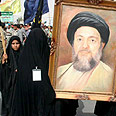
Shiite Muslims marking the holiday of Ashura
Photo: AP

Shiite protestors, Iraq
Shi’a Islam is the second largest of the two central Muslim denominations after Sunni Islam. Studies have estimated that there are currently over 185 million Shiites in the world, some 16 percent of all followers of Islam.
Shiites constitute a majority in Iran, Iraq and Azerbaijan. They are also the largest Muslim sect in Bahrain and in Lebanon, where they compromise 40 percent of the general population; Lebanese Shiites are referred to as Metualis.
Significantly large Shiite communities exist in other Islamic nations; these include India, Pakistan, Turkey, Yemen, Afghanistan and Saudi Arabia. In Syria the leadership is controlled by the Alawi minority group, a splinter of Shiism.
The schism between the Sunni and Shiite Islam originates from the earliest days of Islam in the seventh century, when Ali Ibn Abu Talib's faction contested the Umayyad Dynasty's right to the caliphate (the caliph is considered to the prophet's successor on earth). According to Abu Talib's faction only a direct descendent of Ali and Fatimna, the prophet's son-in-law and daughter, was eligible to serve as the imam and lead the religion.
Shi'a Islam, while accepting the canonicity of the Sunnah (the "words and deeds of Muhammad" – Islamic law dictated orally by Muhammad) as the second-most important source of Islamic law after the Koran, does not recognize its decrees as binding and went on to develop doctrines and practices unique to Shiites.
This includes the veneration of the imam, who is attributed supernatural powers. Shiites also believe in the existence of the Mahdi, the so-called "hidden" imam who will reappear on earth as the "redeemer of Islam" and create a utopian Muslim world.
Shiites disagree as to which imam is the last and hidden one. The majority believe that the Mahdi is the twelfth imam, and his supporters are called Atna-Asaryah (literally - men of the twelfth); the term "Shiites" generally refers to this group.
Followers of several religious movements can trace their origins to Shiism as splinter groups began to break off as early as the ninth century; these include the Druze, Alawites, Qarmatians and followers of the Bahai faith.
Shiites have no religiously or organizationally authoritative institution.















